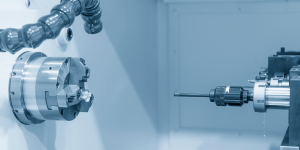CNC turning is a common technique for producing cylindrical components with high precision in the world of precise machining. However, within the realm of CNC turning, two distinct approaches have emerged: The CNC turning in Switzerland and the conventional CNC turning. However, each method has its own benefits and limitations which manufacturers should be aware of. This post is intended to give a comprehensive comparison of the Swiss CNC turning and conventional CNC turning, describing their main features, uses and factors for selection.
What is Swiss CNC Turning and How Is It Different from Conventional CNC turning?
There are two separate techniques of Swiss CNC turning and conventional machining within the precision manufacturing process, each having its own benefits as well as limitations. Swiss CNC turning, also referred to as Swiss-style turning is a process that uses sliding headstock and guide bushing for machining long slender parts with high accuracy. Alternatively, the traditional CNC turning has a fixed headstock and does not require guide bushing; hence it is applicable to more part geometries.

Benefits and Drawbacks of Swiss CNC Turning
The benefits of Swiss CNC turning over the conventional method are especially noticeable in long, thin part machining. The presence of a sliding headstock and guide bushing contributes to the accurate production with high surface finish due to complex geometries. Moreover, the Swiss turning technique provides more rigidity of tools and better chip control which results in an improved performance. Nevertheless, it is worth mentioning that Swiss CNC turning has some limitations as well – higher initial setup costs and programming complexity because of the specificity of the process.
Benefits and Drawbacks of Traditional CNC Turning
As a process within precision machining, conventional CNC turning also has its own strengths and weaknesses. Unlike Swiss CNC turning, it is characterized by a stationary headstock and does not require guide bushing making its application versatile for various part geometries. This flexibility enables machining of a wide range of components, not only long and slender parts. Also, the conventional CNC turning has benefits in terms of lower initial setup costs and relatively easier programming that can lead to cost-effectiveness and faster implementation. But it should be noted that conventional CNC turning may not reach the same level of precision and efficiency as Swiss CNC turning, especially in case of complex geometries and thin components.
Applications and Industries for each Method
It is important to note that when discussing the applications and industries for Swiss CNC turning as well as conventional CNC turning there are clear benefits and drawbacks of both methods. Swiss CNC turning, which is specialized in the machining of long and slender parts with high precision requirements finds numerous applications within aerospace, medical devices as well automotive components industry. Its suitability for complex geometries, with high accuracy makes it ideal to be used in intricate components where precision is very important. In contrast, traditional CNC turning that can cope with a wider variety of part geometries is the norm in general engineering, metal fabrication and consumer electronics. Its ability to produce different parts efficiently makes it applicable where flexibility is critical.

Choosing the Right Method
When we talk about Swiss CNC turning and conventional CNC turning, a few critical factors come into play. It is necessary for manufacturers to critically analyze their machining requirements, assess component geometries and the level of precision desired in order to determine which method would be most suitable for them. During the decision-making process some other factors like production volume, part complexity, material characteristics and tolerance requirements should also be considered. Additionally, the presence of competent operators and potential future scalability should not be disregarded in determining which method is appropriate for machining. Through careful contemplation of these factors, manufacturers can make well-informed decisions based on their manufacturing objectives and overall corporate strategies to maximize machining for efficiency and quality.
Conclusion
To conclude, the comparison of Swiss CNC turning and conventional CNC turning gives manufacturers actionable knowledge in precision machining. Understanding the unique properties, applications and considerations of each method is necessary to make sound decisions that meet specific machining requirements and production objectives. Swiss CNC turning is also highly accurate in the precision machining of long, slender components and this makes it a favoured choice for industries like that of aerospace medical devices or automotive segments where complex geometries require high accuracy. However, the flexibility in accommodating a broader variety of part geometric complexity that conventional CNC turning offers makes it an ideal alternative for general engineering, metal fabrication and consumer electronics industries. Through proper analysis of factors like part complexity, production volume, material characteristics and cost implications the manufacturers are able to make a choice on which turning method is right for them in order to meet the needs of different industries.
